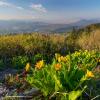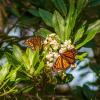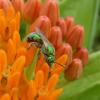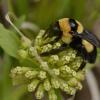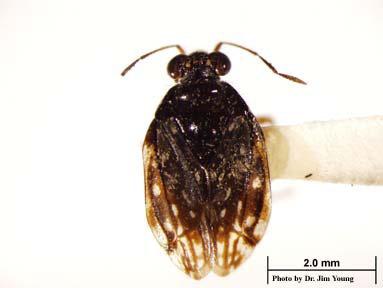
(Heteroptera: Saldidae)
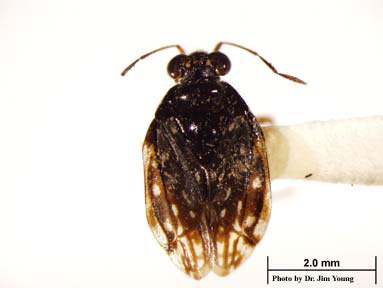
Photo by Jim Young
Please contact The Xerces Society for information on how to obtain permission to use this image.
Saldula villosa has an oval body shape. It ranges in length from 3.75 mm to 4.43 mm and the width of its pronotum ranges from 1.50 mm to 2.08 mm. It has a general black color with pruinose blue and yellow spots. Its eyes are pale brown to red-brown and its head is black with yellow spots on each side of the ocelli (Hodgden, 1949). S. villosa can be distinguished from S. severini and S. orbiculata by the distinct deep depression of the anterior lobe of the pronotum behind the median fovea, by the color pattern of the hemelyrta, and the longer hind tibia and second antennal segment. Also S. severini and S. oriculata do not have the blue spot on the corium next to the apex of the claval suture (Hodgden, 1949).
We were unable to find information on specific documentation of S. villosa’s life history. Other Saldula species lay eggs at the base of grass blades, insert their eggs into plant tissue, or glue them to other surfaces. Eggs for other studied Saldula species range in size from .6 mm x .15 mm to 1.2 mm x 0.3 mm and are of elongate cylindrical shape. Eggs hatched in 7 to 12 days and it then took 16 to 17 days to reach adulthood (Menke, 1979).
Other Saldula species vary in overwintering habits. Many overwinter as adults, but some overwinter as eggs, and others are thought to be active during warm periods throughout the winter (Menke, 1979).
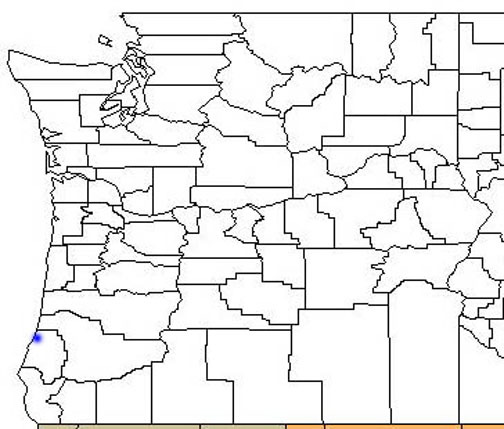
Historic range
The historic range of S. villosa is not well known. Specimens were collected in Marin and Sonoma Counties in California and a single specimen found from Coos Bay County in Oregon. The Oregon specimen was collected 4.5 miles north of North Bend on 4/26/37 (OSU Arthropod Collection).
Current range
S. villosa’s current range in Oregon is unknown. Due to the species small size, limited range, and rarity there are no amateur recordings. There have been few surveys conducted for the species. John D. Lattin, professor emeritus Oregon State University, conducted several searches for the species (circa 1960’s) but never located specimens of this species. He is unaware of anyone else that has searched and found it. (Lattin personal communication). Kerrie Palermo, Coos Bay District Wildlife Biologist, is not aware of any surveys performed for this species in the Coos Bay District. (Palmero personal communication).
This species is probably associated with salt marshes.
Heritage Global Rank: G3
Heritage State Rank: Oregon (S1)
The threats to this species are unknown. Loss of salt marsh habitat is a potential threat. The lack of knowledge of current range makes understanding potential threats difficult.
Due to its size and limited understanding of its specific life history it is difficult to determine what conservation steps are necessary for this species. Avoid disturbance of S. villosa’s potential habitat (salt marshes), take measures to maintain or enhance potential habitat, and undertake surveys within these habitats prior to management actions that may impact the habitat. Surveys of its known historic Oregon location are needed to determine if the species can be found again.
Henry, T.J. and R.C. Froeschner (eds.). 1988. Catalog of the Heteroptera, or True Bugs, of Canada and the Continental United States. E.J. Brill, New York, NY. 958 p.
Hodgden, B.B. 1949. New Saldidae From the Western Hemisphere (Hemiptera). The Journal of the Kansas Entomological Society 22: 162-165.
Menke, A.E. (ed.). 1979. The Semiaquatic and Aquatic Hemiptera of California (Heteroptera: Hemiptera). Bulletin of the California Insect Survey 21: 16-33.
Merritt R.W. and K.W. Cummins (eds.). 1986. An Introduction to the Aquatic Insects of North America. Third Edition. Kendall/Hunt Publishing, Dubuque, IA. 862 p.
NatureServe. 2007. NatureServe Explorer: An online encyclopedia of life [web application]. Version 6.2. NatureServe, Arlington, Virginia.
Oregon State University Arthropod Collection. Dr. Christopher J. Marshall, Collection Manager and Assistant Curator. Corvallis, OR. Species ID # 000087487, 000087509, and 000084244.
Profile prepared by the Xerces Society for Invertebrate Conservation



